

Compact Muon Solenoid
LHC, CERN
| CMS-HIN-16-023 ; CERN-EP-2018-110 | ||
| Measurement of nuclear modification factors of $ \Upsilon(\mathrm{1S})$, $ \Upsilon(\mathrm{2S})$, and $ \Upsilon(\mathrm{3S})$ mesons in PbPb collisions at $ {\sqrt {\smash [b]{s_{_{\mathrm {NN}}}}}} = $ 5.02 TeV | ||
| CMS Collaboration | ||
| 23 May 2018 | ||
| Phys. Lett. B 790 (2019) 270 | ||
| Abstract: The cross sections for $ \Upsilon(\mathrm{1S})$, $ \Upsilon(\mathrm{2S})$, and $ \Upsilon(\mathrm{3S})$ production in lead-lead (PbPb) and proton-proton (pp) collisions at $ {\sqrt {\smash [b]{s_{_{\mathrm {NN}}}}}} = $ 5.02 TeV have been measured using the CMS detector at the LHC. The nuclear modification factors, $ {R_{\mathrm{AA}}} $, derived from the PbPb-to-pp ratio of yields for each state, are studied as functions of meson rapidity and transverse momentum, as well as PbPb collision centrality. The yields of all three states are found to be significantly suppressed, and compatible with a sequential ordering of the suppression, $ {R_{\mathrm{AA}}}( \Upsilon(\mathrm{1S}) ) > {R_{\mathrm{AA}}}( \Upsilon(\mathrm{2S})) > {R_{\mathrm{AA}}} (\Upsilon(\mathrm{3S}) )$. The suppression of $ \Upsilon(\mathrm{1S})$ is larger than that seen at $ {\sqrt {\smash [b]{s_{_{\mathrm {NN}}}}}} = $ 2.76 TeV, although the two are compatible within uncertainties. The upper limit on the ${R_{\mathrm{AA}}}$ of $ \Upsilon(\mathrm{3S})$ integrated over $ {p_{\mathrm{T}}} $ and rapidity is 0.096 at 95% confidence level, which is the strongest suppression observed for any hadron species in heavy ion collisions to date. | ||
| Links: e-print arXiv:1805.09215 [hep-ex] (PDF) ; CDS record ; inSPIRE record ; HepData record ; CADI line (restricted) ; | ||
| Figures & Tables | Summary | Additional Figures | References | CMS Publications |
|---|
| Figures | |

png pdf |
Figure 1:
Invariant mass distribution of muon pairs in pp (left) and PbPb (right) collisions, for the kinematic range $ {p_{\mathrm {T}}} ^{{{{\mu ^+}} {{\mu ^-}}}} < $ 30 GeV and $ | y^{{{{\mu ^+}} {{\mu ^-}}}} | < $ 2.4. In both figures, the results of the fits to the data are shown as solid blue lines. The separate yields for each $ {\Upsilon} $ state in pp are shown as dashed red lines in the left panel. The dashed red lines in the right panel are the result of the fits in PbPb (blue solid line). In order to show the suppression of all three $\Upsilon $ states, the amplitudes of the corresponding peaks are increased above those found in the fit by the inverse of the measured ${R_ {\mathrm {AA}}} $ for the corresponding $\Upsilon $ meson. |
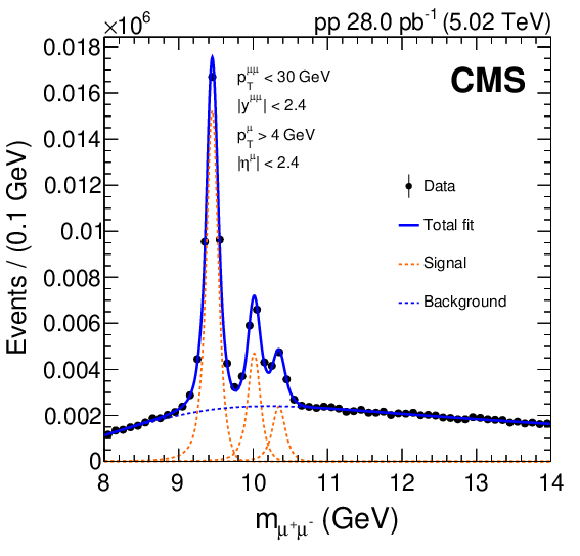
png pdf |
Figure 1-a:
Invariant mass distribution of muon pairs in pp collisions, for the kinematic range $ {p_{\mathrm {T}}} ^{{{{\mu ^+}} {{\mu ^-}}}} < $ 30 GeV and $ | y^{{{{\mu ^+}} {{\mu ^-}}}} | < $ 2.4. The results of the fits to the data are shown as solid blue lines. The separate yields for each $ {\Upsilon} $ state are shown as dashed red lines. |
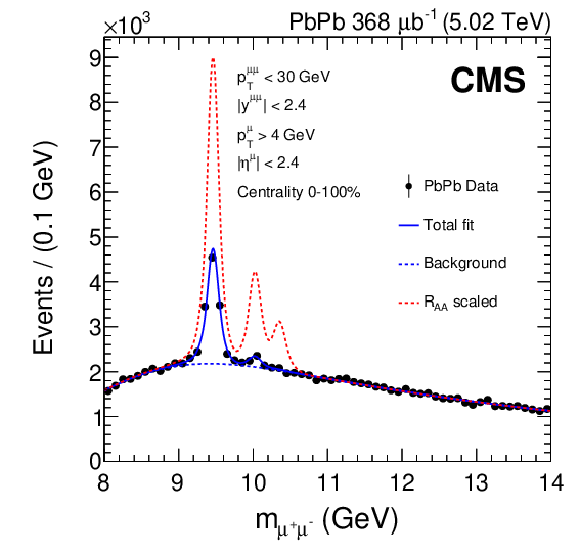
png pdf |
Figure 1-b:
Invariant mass distribution of muon pairs in PbPb collisions, for the kinematic range $ {p_{\mathrm {T}}} ^{{{{\mu ^+}} {{\mu ^-}}}} < $ 30 GeV and $ | y^{{{{\mu ^+}} {{\mu ^-}}}} | < $ 2.4. The results of the fits to the data are shown as solid blue lines. The dashed red lines are the result of the fits (blue solid line). In order to show the suppression of all three $\Upsilon $ states, the amplitudes of the corresponding peaks are increased above those found in the fit by the inverse of the measured ${R_ {\mathrm {AA}}} $ for the corresponding $\Upsilon $ meson. |
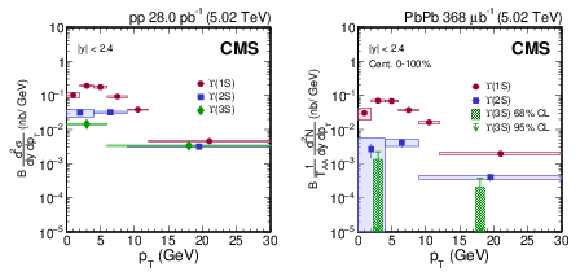
png pdf |
Figure 2:
Differential cross sections of the $ \Upsilon(\mathrm{1S})$, $ \Upsilon(\mathrm{2S})$, and $ \Upsilon(\mathrm{3S})$ mesons as a function of $ {p_{\mathrm {T}}} $ for pp (left) and PbPb (right) collisions. The error bars represent the statistical uncertainties and the boxes the systematic uncertainties. For the $ \Upsilon(\mathrm{3S})$ meson in PbPb collisions, the upper limits at 68% (green box) and 95% (green arrow) CL are shown, and are calculated for the same bins as for the pp dataset. The global integrated luminosity uncertainties of 2.3% in pp collisions and $ ^{+3.4}_{-3.9}$% in PbPb collisions are not shown. |

png pdf |
Figure 2-a:
Differential cross sections of the $ \Upsilon(\mathrm{1S})$, $ \Upsilon(\mathrm{2S})$, and $ \Upsilon(\mathrm{3S})$ mesons as a function of $ {p_{\mathrm {T}}} $ for pp PbPb collisions. The error bars represent the statistical uncertainties and the boxes the systematic uncertainties. The global integrated luminosity uncertainty of 2.3% in pp collisions is not shown. |
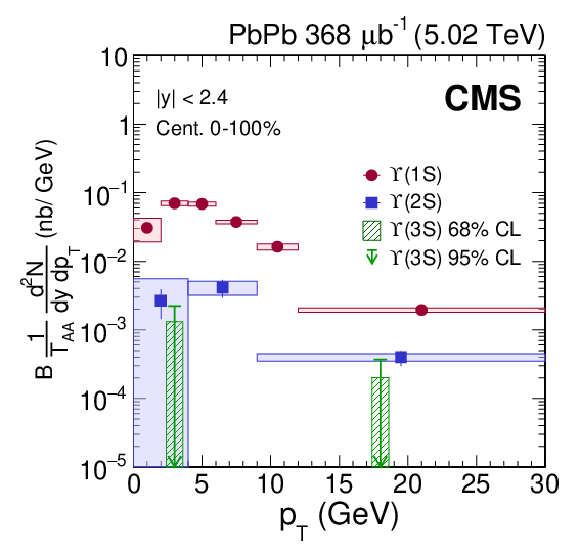
png pdf |
Figure 2-b:
Differential cross sections of the $ \Upsilon(\mathrm{1S})$, $ \Upsilon(\mathrm{2S})$, and $ \Upsilon(\mathrm{3S})$ mesons as a function of $ {p_{\mathrm {T}}} $ for pp PbPb collisions. The error bars represent the statistical uncertainties and the boxes the systematic uncertainties. For the $ \Upsilon(\mathrm{3S})$ meson, the upper limits at 68% (green box) and 95% (green arrow) CL are shown, and are calculated for the same bins as for the pp dataset. The global integrated luminosity uncertainty of $ ^{+3.4}_{-3.9}$% in PbPb collisions is not shown. |
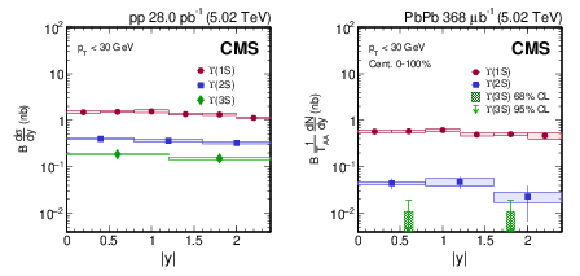
png pdf |
Figure 3:
Differential cross sections of the $ \Upsilon(\mathrm{1S})$, $ \Upsilon(\mathrm{2S})$, and $ \Upsilon(\mathrm{3S})$ mesons as a function of rapidity for pp (left) and PbPb (right) collisions. The error bars represent the statistical uncertainties and the boxes the systematic uncertainties. For the $ \Upsilon(\mathrm{3S})$ meson in PbPb collisions, the upper limits at 68% (green box) and 95% (green arrow) CL are shown. The global integrated luminosity uncertainties of 2.3% in pp collisions and $ ^{+3.4}_{-3.9}$% in PbPb collisions are not shown. |
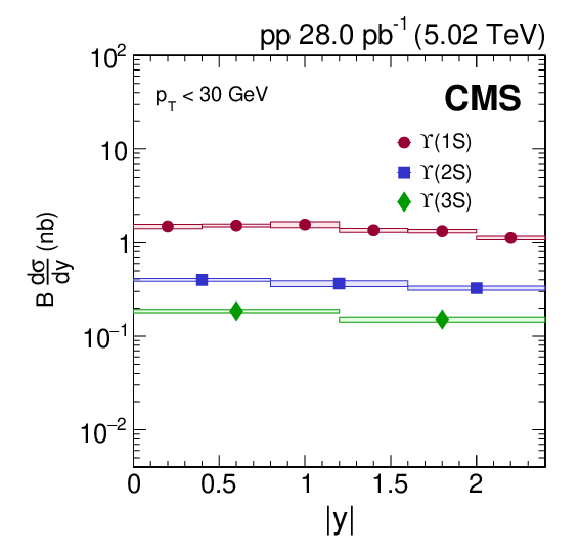
png pdf |
Figure 3-a:
Differential cross sections of the $ \Upsilon(\mathrm{1S})$, $ \Upsilon(\mathrm{2S})$, and $ \Upsilon(\mathrm{3S})$ mesons as a function of rapidity for pp collisions. The error bars represent the statistical uncertainties and the boxes the systematic uncertainties. The global integrated luminosity uncertainty of 2.3% in pp collisions is not shown. |
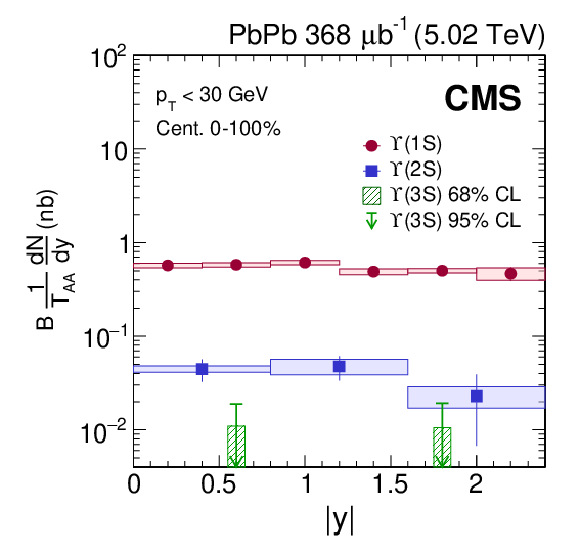
png pdf |
Figure 3-b:
Differential cross sections of the $ \Upsilon(\mathrm{1S})$, $ \Upsilon(\mathrm{2S})$, and $ \Upsilon(\mathrm{3S})$ mesons as a function of rapidity for PbPb collisions. The error bars represent the statistical uncertainties and the boxes the systematic uncertainties. For the $ \Upsilon(\mathrm{3S})$ meson, the upper limits at 68% (green box) and 95% (green arrow) CL are shown. The global integrated luminosity uncertainty of $ ^{+3.4}_{-3.9}$% in PbPb collisions is not shown. |
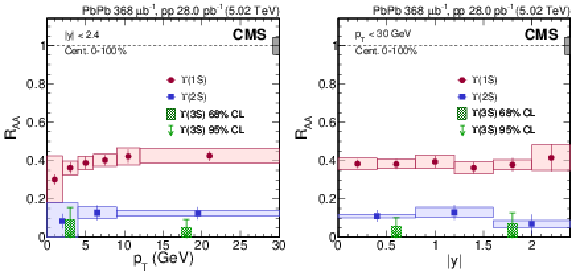
png pdf |
Figure 4:
Nuclear modification factors for $ \Upsilon(\mathrm{1S})$, $ \Upsilon(\mathrm{2S})$ and $ \Upsilon(\mathrm{3S})$ mesons as functions of $ {p_{\mathrm {T}}} $ (left) and rapidity (right). The error bars represent the statistical uncertainties and the boxes the systematic uncertainties. For the $ \Upsilon(\mathrm{3S})$ meson, the upper limits at 68% (green box) and 95% (green arrow) CL are shown. The gray box near the line at unity displays the global uncertainty, which combines the uncertainties from $ {T_{{\mathrm {AA}}}} $, pp luminosity, and PbPb $ {N_{\mathrm {MB}}} $. |
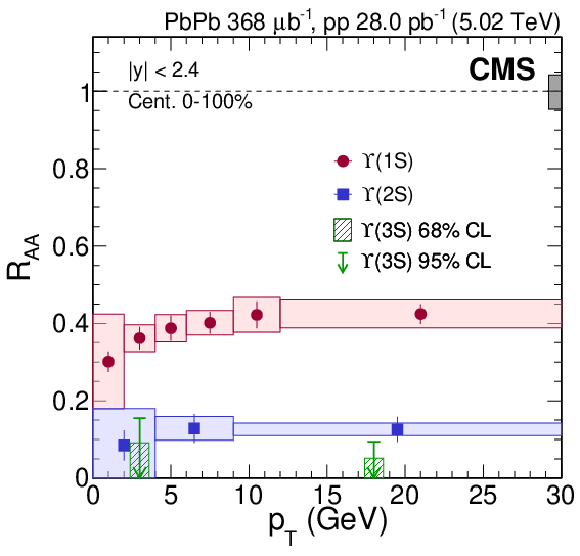
png pdf |
Figure 4-a:
Nuclear modification factors for $ \Upsilon(\mathrm{1S})$, $ \Upsilon(\mathrm{2S})$ and $ \Upsilon(\mathrm{3S})$ mesons as functions of $ {p_{\mathrm {T}}} $. The error bars represent the statistical uncertainties and the boxes the systematic uncertainties. For the $ \Upsilon(\mathrm{3S})$ meson, the upper limits at 68% (green box) and 95% (green arrow) CL are shown. The gray box near the line at unity displays the global uncertainty, which combines the uncertainties from $ {T_{{\mathrm {AA}}}} $, pp luminosity, and PbPb $ {N_{\mathrm {MB}}} $. |
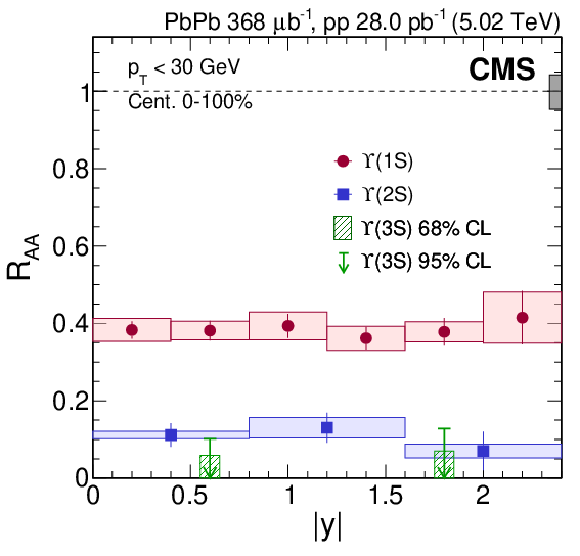
png pdf |
Figure 4-b:
Nuclear modification factors for $ \Upsilon(\mathrm{1S})$, $ \Upsilon(\mathrm{2S})$ and $ \Upsilon(\mathrm{3S})$ mesons as functions of rapidity. The error bars represent the statistical uncertainties and the boxes the systematic uncertainties. For the $ \Upsilon(\mathrm{3S})$ meson, the upper limits at 68% (green box) and 95% (green arrow) CL are shown. The gray box near the line at unity displays the global uncertainty, which combines the uncertainties from $ {T_{{\mathrm {AA}}}} $, pp luminosity, and PbPb $ {N_{\mathrm {MB}}} $. |
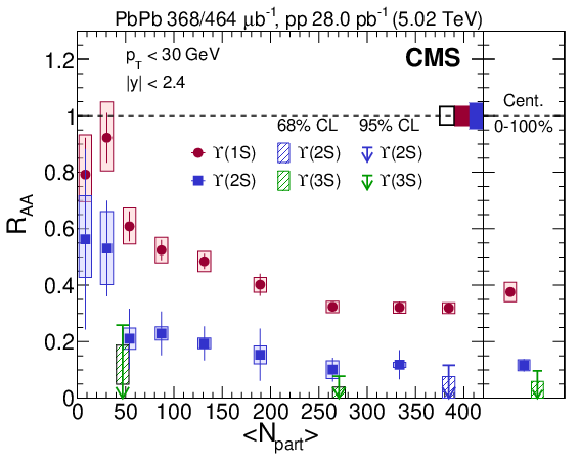
png pdf |
Figure 5:
Nuclear modification factors for the $ \Upsilon(\mathrm{1S})$, $ \Upsilon(\mathrm{2S})$ and $ \Upsilon(\mathrm{3S})$ mesons as a function of $< {N_{\text {part}}} > $. The boxes at the dashed line at unity represent global uncertainties: the open box for the integrated luminosity in pp collisions and ${N_{\mathrm {MB}}}$ in PbPb collisions, while the full boxes show the uncertainties of pp yields for $ \Upsilon(\mathrm{1S})$ and $ \Upsilon(\mathrm{2S})$ states (with the larger box corresponding to the excited state). For the $ \Upsilon(\mathrm{3S})$ meson, the upper limits at 68% (green box) and 95% (green arrow) CL are shown. |
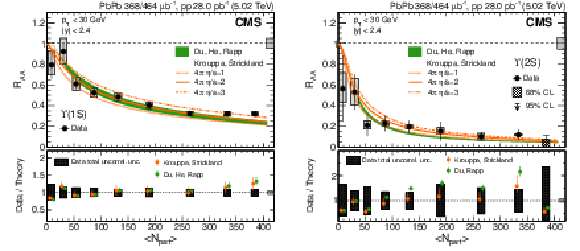
png pdf |
Figure 6:
Nuclear modification factors for the $ \Upsilon(\mathrm{1S})$ (left) and $ \Upsilon(\mathrm{2S})$ (right) mesons as a function of $< {N_{\text {part}}} > $ compared to calculations from Krouppa and Strickland [9], and Du, He, and Rapp [12]. The box at the dashed line at unity represents the global uncertainty from the integrated luminosity in pp collisions, ${N_{\mathrm {MB}}}$ in PbPb collisions, and the total uncertainty in the pp yields. The data to theory ratios are shown in the bottom panels. For Ref. [9], the points correspond to the $4\pi \eta /s=$ 2 curve, while the error bars show the difference between this one and the other two $\eta /s$ curves. For Ref. [12], the points and error bars correspond to the center and width of the published theory band, respectively. |
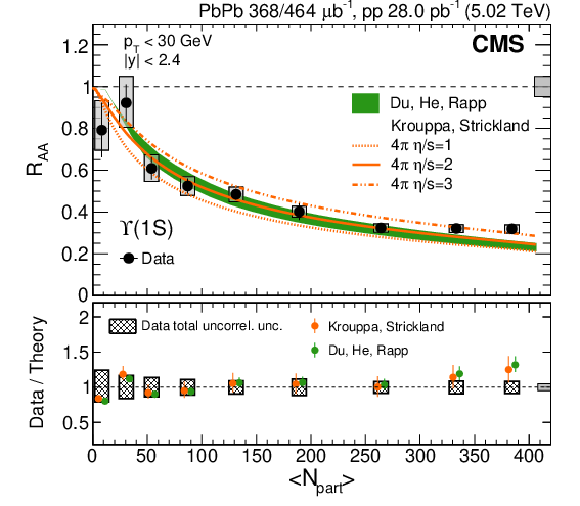
png pdf |
Figure 6-a:
Nuclear modification factors for the $ \Upsilon(\mathrm{1S})$ meson as a function of $< {N_{\text {part}}} > $ compared to calculations from Krouppa and Strickland [9], and Du, He, and Rapp [12]. The box at the dashed line at unity represents the global uncertainty from the integrated luminosity in pp collisions, ${N_{\mathrm {MB}}}$ in PbPb collisions, and the total uncertainty in the pp yields. The data to theory ratios are shown in the bottom panel. For Ref. [9], the points correspond to the $4\pi \eta /s=$ 2 curve, while the error bars show the difference between this one and the other two $\eta /s$ curves. For Ref. [12], the points and error bars correspond to the center and width of the published theory band, respectively. |
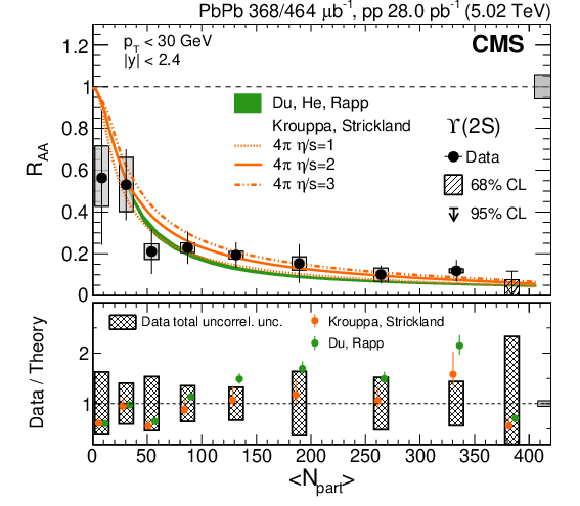
png pdf |
Figure 6-b:
Nuclear modification factors for the $ \Upsilon(\mathrm{2S})$ meson as a function of $< {N_{\text {part}}} > $ compared to calculations from Krouppa and Strickland [9], and Du, He, and Rapp [12]. The box at the dashed line at unity represents the global uncertainty from the integrated luminosity in pp collisions, ${N_{\mathrm {MB}}}$ in PbPb collisions, and the total uncertainty in the pp yields. The data to theory ratios are shown in the bottom panel. For Ref. [9], the points correspond to the $4\pi \eta /s=$ 2 curve, while the error bars show the difference between this one and the other two $\eta /s$ curves. For Ref. [12], the points and error bars correspond to the center and width of the published theory band, respectively. |
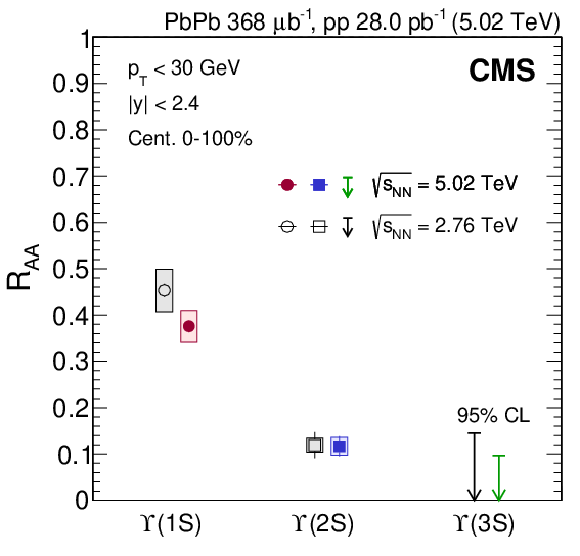
png pdf |
Figure 7:
Comparison of ${R_ {\mathrm {AA}}}$ values for the $ \Upsilon(\mathrm{1S})$,$ \Upsilon(\mathrm{2S})$ and $ \Upsilon(\mathrm{3S})$ mesons at $ {\sqrt {\smash [b]{s_{_{\mathrm {NN}}}}}} = $ 5.02 TeV and $ {\sqrt {\smash [b]{s_{_{\mathrm {NN}}}}}} = $ 2.76 TeV [21] for integrated centrality in the full kinematic range. The error bars represent the statistical uncertainties and the boxes the systematic uncertainties, including global uncertainties. |
| Tables | |
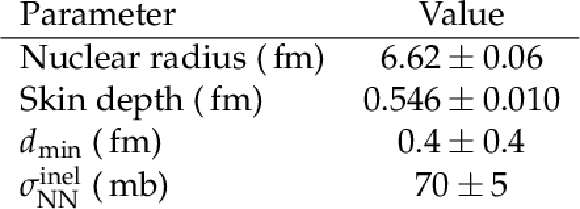
png pdf |
Table 1:
Glauber model parameters for PbPb collisions at $ {\sqrt {\smash [b]{s_{_{\mathrm {NN}}}}}} = $ 5.02 TeV. |
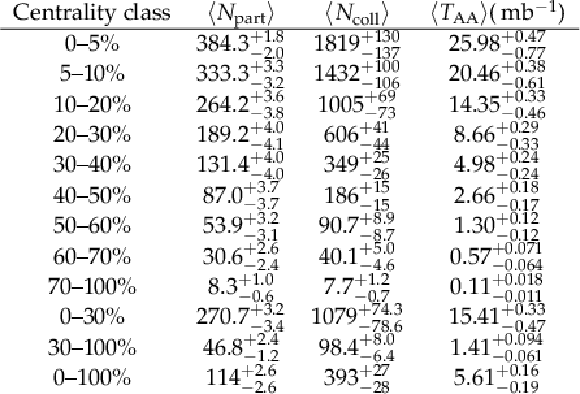
png pdf |
Table 2:
Centrality classes, average number of participating nucleons ($< {N_{\text {part}}} > $), number of binary collisions (${N_{\text {coll}}}$), and the nuclear overlap (${T_{{\mathrm {AA}}}}$) for PbPb collisions at $ {\sqrt {\smash [b]{s_{_{\mathrm {NN}}}}}} = $ 5.02 TeV, obtained using the Glauber model parameters of Table 1. |
| Summary |
| Data from pp and PbPb collisions at $ {\sqrt {\smash [b]{s_{_{\mathrm {NN}}}}}} = $ 5.02 TeV collected with the CMS detector were analyzed to measure the cross sections of $\Upsilon(\mathrm{1S})$, $\Upsilon(\mathrm{2S})$, and $\Upsilon(\mathrm{3S})$ mesons and their nuclear modification factors as functions of $\Upsilon$ transverse momentum ($ {p_{\mathrm{T}}} $) and rapidity ($ y$ ), as well as PbPb collision centrality. A gradual decrease in ${R_{\mathrm{AA}}}$ with $ < {N_{\mathrm{part}}} >$ for the $\Upsilon(\mathrm{1S})$ and $\Upsilon(\mathrm{2S})$ states is observed, while no significant dependence on $ {p_{\mathrm{T}}} $ or $ y$ is found in the measured region. The suppression of $\Upsilon(\mathrm{1S})$ is larger than that seen at $ {\sqrt {\smash [b]{s_{_{\mathrm {NN}}}}}} = $ 2.76 TeV, although the two are compatible within uncertainties. The ${R_{\mathrm{AA}}}$ of the $\Upsilon(\mathrm{3S})$ state is measured to be below 0.096 at 95% confidence level, making this the smallest ${R_{\mathrm{AA}}}$ value found for any hadron species in heavy ion collisions. |
| Additional Figures | |
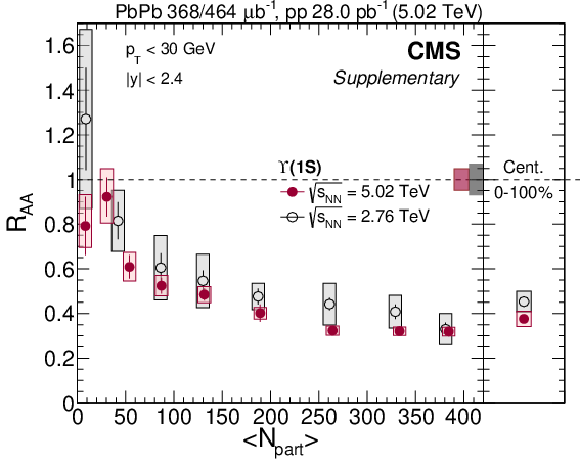
png pdf |
Additional Figure 1:
Nuclear modification factor for the ${\Upsilon \mathrm {(1S)}}$ meson as a function of $< {{N_{\text {part}}}} > $ at $ {\sqrt {\smash [b]{s_{_{\mathrm {NN}}}}}} = $ 2.76 TeV (black points) [1] and $ {\sqrt {\smash [b]{s_{_{\mathrm {NN}}}}}} = $ 5.02 TeV (red points). The error bars and boxes represent the statistical and systematic uncertainties, respectively. The black and red boxes at unity represent the global uncertainties, which combine uncertainties from the pp luminosity and yield, and PbPb $N_{\mathrm {MB}}$, for the two energies 2.76 and 5.02 TeV, respectively. |
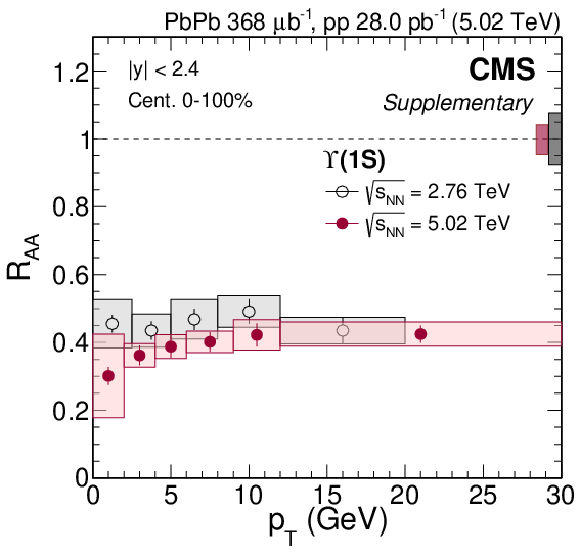
png pdf |
Additional Figure 2:
Nuclear modification factors for the ${\Upsilon \mathrm {(1S)}}$ meson as a function of ${p_{\mathrm {T}}}$ at $ {\sqrt {\smash [b]{s_{_{\mathrm {NN}}}}}} = $ 2.76 TeV (black points) [1] and $ {\sqrt {\smash [b]{s_{_{\mathrm {NN}}}}}} = $ 5.02 TeV (red points). The error bars and boxes represent the statistical and systematic uncertainties, respectively. The black and red boxes at unity represent the global uncertainties, which combine uncertainties from ${{T_{{{\mathrm {AA}}}}}}$, pp luminosity, and PbPb $N_{\mathrm {MB}}$, for the two energies 2.76 and 5.02 TeV, respectively. |
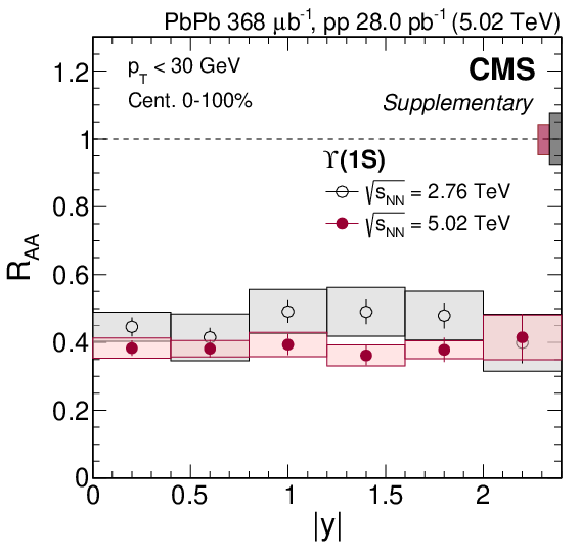
png pdf |
Additional Figure 3:
Nuclear modification factors for the ${\Upsilon \mathrm {(1S)}}$ meson as a function of $y$ at $ {\sqrt {\smash [b]{s_{_{\mathrm {NN}}}}}} = $ 2.76 TeV (black points) [1] and $ {\sqrt {\smash [b]{s_{_{\mathrm {NN}}}}}} = $ 5.02 TeV (red points). The error bars and boxes represent the statistical and systematic uncertainties, respectively. The black and red boxes at unity represent the global uncertainties, which combine uncertainties from ${{T_{{{\mathrm {AA}}}}}}$, pp luminosity, and PbPb $N_{\mathrm {MB}}$, for the two energies 2.76 and 5.02 TeV, respectively. |
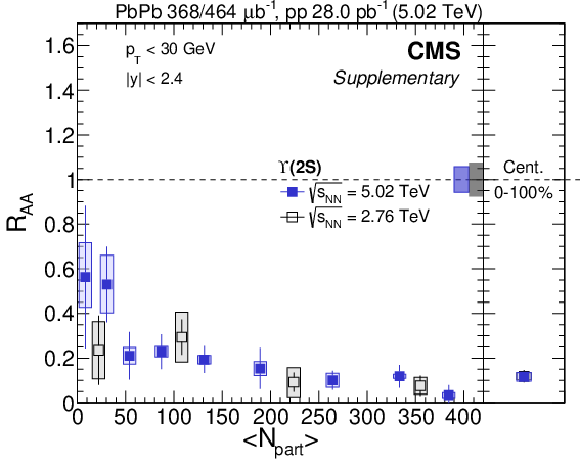
png pdf |
Additional Figure 4:
Nuclear modification factor for the ${\Upsilon \mathrm {(2S)}}$ meson as a function of $< {{N_{\text {part}}}} > $ at $ {\sqrt {\smash [b]{s_{_{\mathrm {NN}}}}}} = $ 2.76 TeV (black points) [1] and $ {\sqrt {\smash [b]{s_{_{\mathrm {NN}}}}}} = $ 5.02 TeV (blue points). The error bars and boxes represent the statistical and systematic uncertainties, respectively. The black and blue boxes at unity represent the global uncertainties, which combine uncertainties from the pp luminosity and yield, and PbPb $N_{\mathrm {MB}}$, for the two energies 2.76 and 5.02 TeV, respectively. |
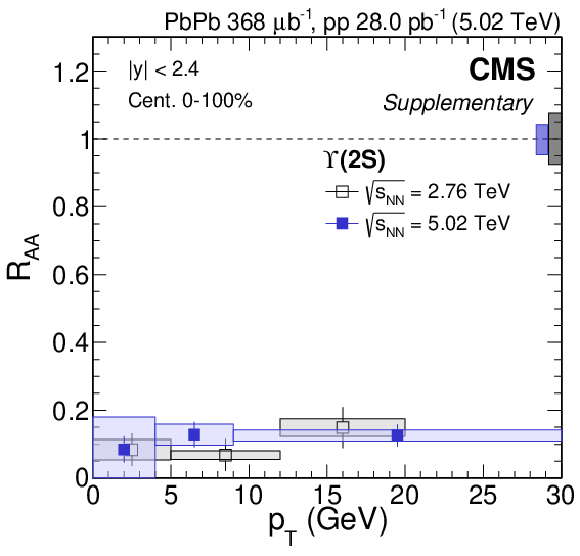
png pdf |
Additional Figure 5:
Nuclear modification factors for the ${\Upsilon \mathrm {(2S)}}$ meson as a function of ${p_{\mathrm {T}}}$ at $ {\sqrt {\smash [b]{s_{_{\mathrm {NN}}}}}} = $ 2.76 TeV (black points) [1] and $ {\sqrt {\smash [b]{s_{_{\mathrm {NN}}}}}} = $ 5.02 TeV (blue points). The error bars and boxes represent the statistical and systematic uncertainties, respectively. The black and blue boxes at unity represent the global uncertainties, which combine uncertainties from ${{T_{{{\mathrm {AA}}}}}}$, pp luminosity, and PbPb $N_{\mathrm {MB}}$, for the two energies 2.76 and 5.02 TeV, respectively. |

png pdf |
Additional Figure 6:
Nuclear modification factors for the ${\Upsilon \mathrm {(2S)}}$ meson as a function of $y$ at $ {\sqrt {\smash [b]{s_{_{\mathrm {NN}}}}}} = $ 2.76 TeV (black points) [1] and $ {\sqrt {\smash [b]{s_{_{\mathrm {NN}}}}}} = $ 5.02 TeV (blue points). The error bars and boxes represent the statistical and systematic uncertainties, respectively. The black and blue boxes at unity represent the global uncertainties, which combine uncertainties from ${{T_{{{\mathrm {AA}}}}}}$, pp luminosity, and PbPb $N_{\mathrm {MB}}$, for the two energies 2.76 and 5.02 TeV, respectively. |
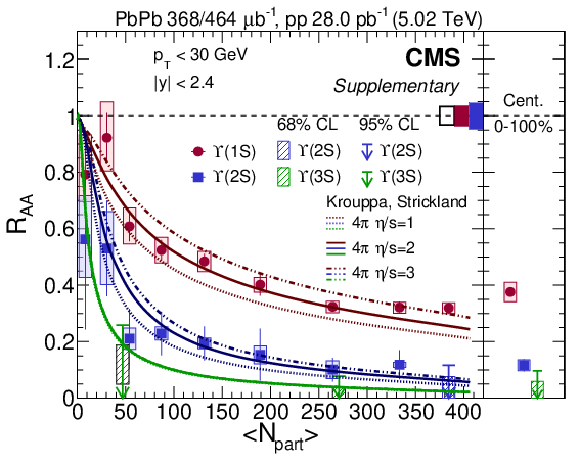
png pdf |
Additional Figure 7:
Nuclear modification factors for the the ${\Upsilon \mathrm {(1S)}}$, ${\Upsilon \mathrm {(2S)}}$ and ${\Upsilon \mathrm {(3S)}}$ mesons as a function of $< {{N_{\text {part}}}} > $. The error bars and boxes represent the statistical and systematic uncertainties, respectively. The open box at unity, which applies to both the ${\Upsilon \mathrm {(1S)}}$ and ${\Upsilon \mathrm {(2S)}}$ mesons, represents the global uncertainty, combining the uncertainties in the integrated luminosity in pp collisions and ${{N_{\mathrm {MB}}}}$ in PbPb collisions. The red and blue boxes show the uncertainties from pp yields for the ${\Upsilon \mathrm {(1S)}}$ and ${\Upsilon \mathrm {(2S)}}$ states, respectively. For the ${\Upsilon \mathrm {(3S)}}$ meson, the upper limits at 68% (green box) and 95% (green arrow) CL are shown. For the centrality-integrated results in the right sub-panel, the systematic uncertainty values include the global uncertainties. The lines represent calculations from Ref. [2]. |
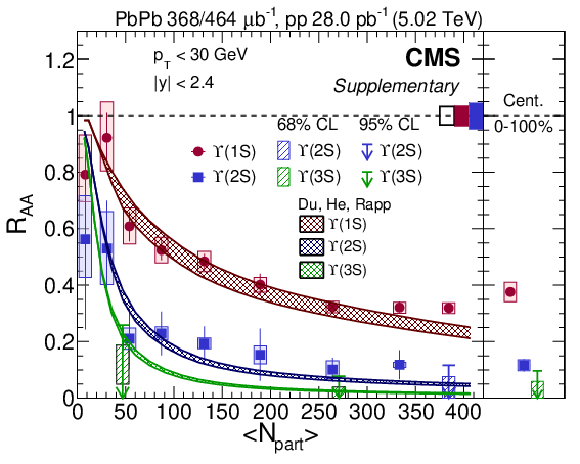
png pdf |
Additional Figure 8:
Nuclear modification factors for the ${\Upsilon \mathrm {(1S)}}$, ${\Upsilon \mathrm {(2S)}}$ and ${\Upsilon \mathrm {(3S)}}$ mesons as a function of $< {{N_{\text {part}}}} > $. The error bars and boxes represent the statistical and systematic uncertainties, respectively. The open box at unity, which applies to both the ${\Upsilon \mathrm {(1S)}}$ and ${\Upsilon \mathrm {(2S)}}$ mesons, represents the global uncertainty, combining the uncertainties in the integrated luminosity in pp collisions and ${{N_{\mathrm {MB}}}}$ in PbPb collisions. The red and blue boxes show the uncertainties from pp yields for the ${\Upsilon \mathrm {(1S)}}$ and ${\Upsilon \mathrm {(2S)}}$ states, respectively. For the ${\Upsilon \mathrm {(3S)}}$ meson, the upper limits at 68% (green box) and 95% (green arrow) CL are shown. For the centrality-integrated results in the right sub-panel, the systematic uncertainty values include the global uncertainties. The bands represent calculations from Ref. [3]. |
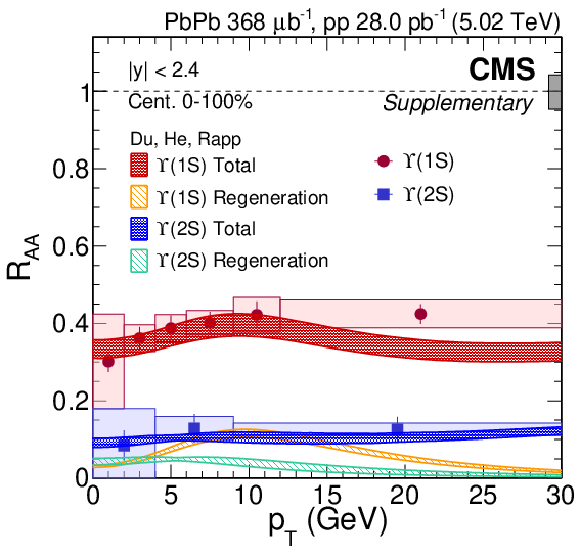
png pdf |
Additional Figure 9:
Nuclear modification factors for the ${\Upsilon \mathrm {(1S)}}$ and ${\Upsilon \mathrm {(2S)}}$ mesons as a function of ${p_{\mathrm {T}}}$. The error bars and boxes represent the statistical and systematic uncertainties, respectively. The gray box at unity represents the global uncertainty, which combines uncertainties from ${{T_{{{\mathrm {AA}}}}}}$, pp luminosity, and PbPb $N_{\mathrm {MB}}$. The bands represent calculations from Ref. [3], with red (blue) bands showing the total modification factor and orange (teal) bands showing the regeneration component of the calculations for the $ {\Upsilon \mathrm {(1S)}}({\Upsilon \mathrm {(2S)}})$ mesons. |
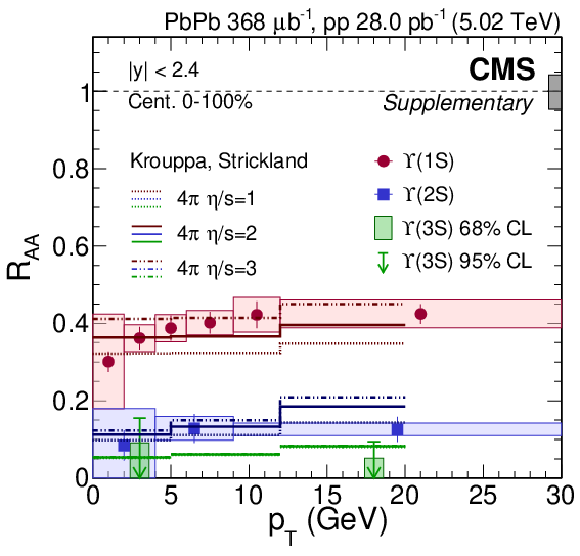
png pdf |
Additional Figure 10:
Nuclear modification factors for the ${\Upsilon \mathrm {(1S)}}$, ${\Upsilon \mathrm {(2S)}}$ and ${\Upsilon \mathrm {(3S)}}$ mesons as a function of ${p_{\mathrm {T}}}$. The error bars and boxes represent the statistical and systematic uncertainties, respectively. The gray box at unity represents the global uncertainty, which combines uncertainties from ${{T_{{{\mathrm {AA}}}}}}$, pp luminosity, and PbPb $N_{\mathrm {MB}}$. For the ${\Upsilon \mathrm {(3S)}}$ meson, the upper limits at 68% (green box) and 95% (green arrow) CL are shown. The lines represent calculations from Ref. [2]. |
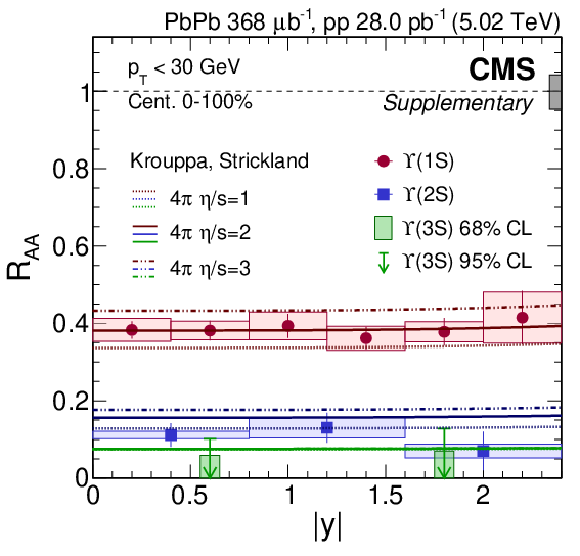
png pdf |
Additional Figure 11:
Nuclear modification factors for the ${\Upsilon \mathrm {(1S)}}$, ${\Upsilon \mathrm {(2S)}}$ and ${\Upsilon \mathrm {(3S)}}$ mesons as a function of $y$. The error bars and boxes represent the statistical and systematic uncertainties, respectively. The gray box at unity represents the global uncertainty, which combines uncertainties from ${{T_{{{\mathrm {AA}}}}}}$, pp luminosity, and PbPb $N_{\mathrm {MB}}$. For the ${\Upsilon \mathrm {(3S)}}$ meson, the upper limits at 68% (green box) and 95% (green arrow) CL are shown. The lines represent calculations from Ref. [2]. |
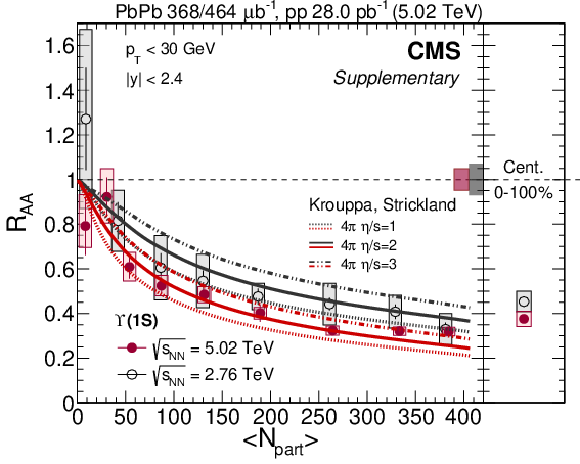
png pdf |
Additional Figure 12:
Nuclear modification factor for the ${\Upsilon \mathrm {(1S)}}$ meson as a function of $< {{N_{\text {part}}}} > $ at $ {\sqrt {\smash [b]{s_{_{\mathrm {NN}}}}}} = $ 2.76 TeV (black points) [1] and $ {\sqrt {\smash [b]{s_{_{\mathrm {NN}}}}}} = $ 2.76 TeV (red points). The error bars and boxes represent the statistical and systematic uncertainties, respectively. The black and red boxes at unity represent the global uncertainties, which combine uncertainties from the pp luminosity and yield, and PbPb $N_{\mathrm {MB}}$, for the two energies 2.76 and 5.02 TeV, respectively. The lines represent calculations from Ref. [2]. |
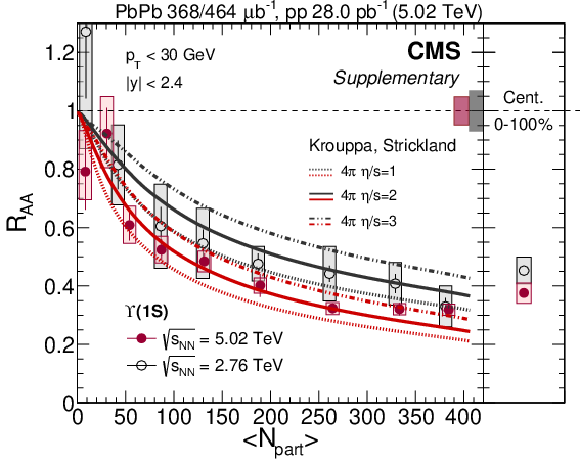
png pdf |
Additional Figure 13:
Same as Fig. 12 but with an expanded Y axis to show more detail. |
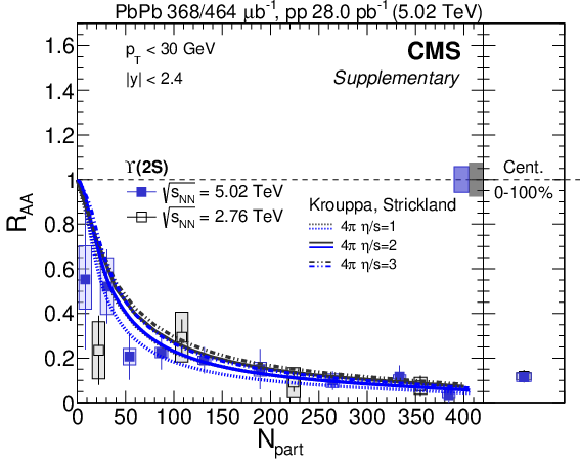
png pdf |
Additional Figure 14:
Nuclear modification factor for the ${\Upsilon \mathrm {(2S)}}$ meson as a function of $< {{N_{\text {part}}}} > $ at $ {\sqrt {\smash [b]{s_{_{\mathrm {NN}}}}}} = $ 2.76 TeV (black points) [1] and $ {\sqrt {\smash [b]{s_{_{\mathrm {NN}}}}}} = $ 2.76 TeV (red points). The error bars and boxes represent the statistical and systematic uncertainties, respectively. The black and red boxes at unity represent the global uncertainties, which combine uncertainties from the pp luminosity and yield, and PbPb $N_{\mathrm {MB}}$, for the two energies 2.76 and 5.02 TeV, respectively. The lines represent calculations from Ref. [2]. |
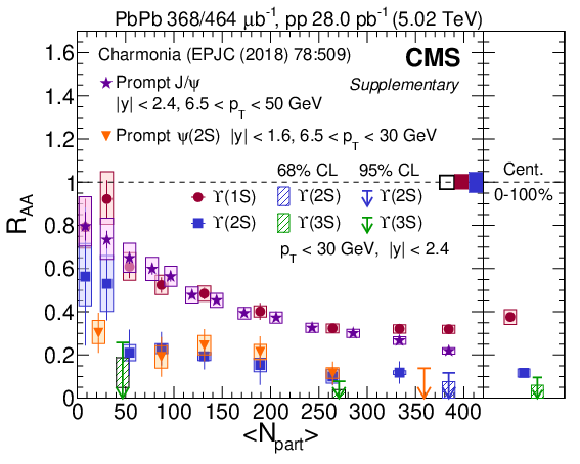
png pdf |
Additional Figure 15:
Nuclear modification factor for the ${\Upsilon \mathrm {(1S)}}$, ${\Upsilon \mathrm {(2S)}}$ and ${\Upsilon \mathrm {(3S)}}$ mesons as well as the $J/\psi $, $\psi $(2S) mesons [4] as a function of $< {{N_{\text {part}}}} > $ at $ {\sqrt {\smash [b]{s_{_{\mathrm {NN}}}}}} = $ 5.02 TeV. The error bars and boxes represent the statistical and systematic uncertainties, respectively. The open box at unity, which applies to both the ${\Upsilon \mathrm {(1S)}}$ and ${\Upsilon \mathrm {(2S)}}$ mesons, represents the global uncertainty, combining the uncertainties in the integrated luminosity in pp collisions and ${{N_{\mathrm {MB}}}}$ in PbPb collisions. The red and blue boxes show the uncertainties of pp yields for ${\Upsilon \mathrm {(1S)}}$ and ${\Upsilon \mathrm {(2S)}}$ states, respectively. For the ${\Upsilon \mathrm {(3S)}}$ meson, the upper limits at 68% (green box) and 95% (green arrow) CL are shown. For the centrality-integrated results in the right sub-panel, the systematic uncertainty values include the global uncertainties. |
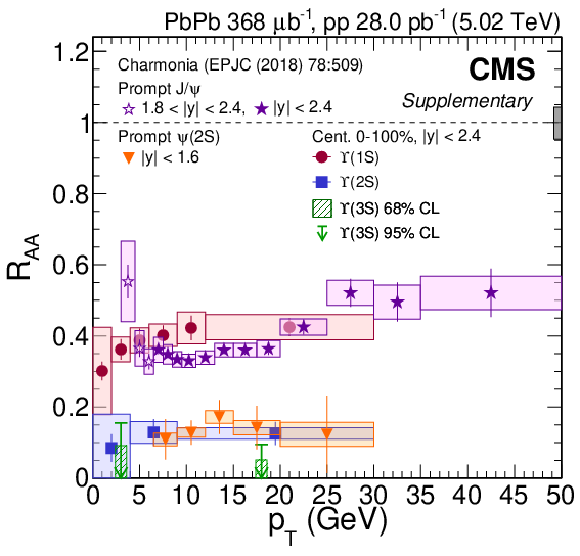
png pdf |
Additional Figure 16:
Nuclear modification factor for the ${\Upsilon \mathrm {(1S)}}$, ${\Upsilon \mathrm {(2S)}}$ and ${\Upsilon \mathrm {(3S)}}$ mesons as well as the $J/\psi $, $\psi $(2S) mesons [4] as a function of ${p_{\mathrm {T}}}$ at $ {\sqrt {\smash [b]{s_{_{\mathrm {NN}}}}}} = $ 5.02 TeV. The error bars and boxes represent the statistical and systematic uncertainties, respectively. The gray box at unity represents the global uncertainty, which combines uncertainties from ${{T_{{{\mathrm {AA}}}}}}$, pp luminosity, and PbPb $N_{\mathrm {MB}}$. For the ${\Upsilon \mathrm {(3S)}}$ meson, the upper limits at 68% (green box) and 95% (green arrow) CL are shown. |
| References | ||||
| 1 | F. Karsch and E. Laermann | Thermodynamics and in-medium hadron properties from lattice QCD | in Quark-Gluon Plasma III, R. C. Hwa and X.-N. Wang, World Scientific Publishing | hep-lat/0305025 |
| 2 | E. V. Shuryak | Theory of hadronic plasma | Sov. Phys. JETP 47 (1978)212 | |
| 3 | T. Matsui and H. Satz | $ \mathrm{J}/\psi $ suppression by quark-gluon plasma formation | PLB 178 (1986) 416 | |
| 4 | S. Digal, P. Petreczky, and H. Satz | Quarkonium feed down and sequential suppression | PRD 64 (2001) 094015 | hep-ph/0106017 |
| 5 | N. Brambilla, J. Ghiglieri, A. Vairo, and P. Petreczky | Static quark-antiquark pairs at finite temperature | PRD 78 (2008) 014017 | 0804.0993 |
| 6 | N. Brambilla et al. | Heavy quarkonium in a weakly-coupled quark-gluon plasma below the melting temperature | JHEP 09 (2010) 038 | 1007.4156 |
| 7 | N. Brambilla et al. | Heavy quarkonium: progress, puzzles, and opportunities | EPJC 71 (2011) 1534 | 1010.5827 |
| 8 | A. Andronic et al. | Heavy-flavour and quarkonium production in the LHC era: from proton-proton to heavy-ion collisions | EPJC 76 (2016) 107 | 1506.03981 |
| 9 | B. Krouppa and M. Strickland | Predictions for bottomonia suppression in 5.023 TeV Pb--Pb collisions | Universe 2 (2016) 16 | 1605.03561 |
| 10 | N. Brambilla, M. A. Escobedo, J. Soto, and A. Vairo | Quarkonium suppression in heavy-ion collisions: an open quantum system approach | PRD 96 (2017) 034021 | 1612.07248 |
| 11 | A. Emerick, X. Zhao, and R. Rapp | Bottomonia in the quark-gluon plasma and their production at RHIC and LHC | EPJA 48 (2012) 72 | 1111.6537 |
| 12 | X. Du, R. Rapp, and M. He | Color screening and regeneration of bottomonia in high-energy heavy-ion collisions | PRC 96 (2017) 054901 | 1706.08670 |
| 13 | R. L. Thews, M. Schroedter, and J. Rafelski | Enhanced $ \mathrm{J}/\psi $ production in deconfined quark matter | PRC 63 (2001) 054905 | hep-ph/0007323 |
| 14 | M. I. Gorenstein, A. P. Kostyuk, H. Stoecker, and W. Greiner | Statistical coalescence model with exact charm conservation | PLB 509 (2001) 277 | hep-ph/0010148 |
| 15 | A. Andronic, P. Braun-Munzinger, K. Redlich, and J. Stachel | Evidence for charmonium generation at the phase boundary in ultra-relativistic nuclear collisions | PLB 652 (2007) 259 | nucl-th/0701079 |
| 16 | A. Mócsy and P. Petreczky | Color screening melts quarkonium | PRLett 99 (2007) 211602 | 0706.2183 |
| 17 | CMS Collaboration | Suppression and azimuthal anisotropy of prompt and nonprompt $ \mathrm{J}/\psi $ production in PbPb collisions at $ {\sqrt {\smash [b]{s_{_{\mathrm {NN}}}}}} = $ 2.76 TeV | EPJC 77 (2017) 252 | CMS-HIN-14-005 1610.00613 |
| 18 | CMS Collaboration | Measurement of prompt $ \psi(2S) \to J/\psi $ yield ratios in Pb-Pb and $ p $-$ p $ collisions at $ {\sqrt {\smash [b]{s_{_{\mathrm {NN}}}}}} = $ 2.76 TeV | PRL 113 (2014) 262301 | CMS-HIN-12-007 1410.1804 |
| 19 | ALICE Collaboration | Differential studies of inclusive $ \mathrm{J}/\psi $ and $ \psi(\text{2S}) $ production at forward rapidity in Pb--Pb collisions at $ {\sqrt {\smash [b]{s_{_{\mathrm {NN}}}}}} = $ 2.76 TeV | JHEP 05 (2016) 179 | 1506.08804 |
| 20 | ALICE Collaboration | Inclusive, prompt and non-prompt J/$ \psi $ production at mid-rapidity in Pb-Pb collisions at $ \sqrt{s_{\rm NN}} = $ 2.76 TeV | JHEP 07 (2015) 051 | 1504.07151 |
| 21 | CMS Collaboration | Suppression of $ \Upsilon\text{1S}, \Upsilon\text{2S} $ and $ \Upsilon\text{3S} $ production in PbPb collisions at $ {\sqrt {\smash [b]{s_{_{\mathrm {NN}}}}}} = $ 2.76 TeV | PLB 770 (2017) 357 | CMS-HIN-15-001 1611.01510 |
| 22 | ALICE Collaboration | Suppression of $ \Upsilon\text{1S} $ at forward rapidity in Pb--Pb collisions at $ {\sqrt {\smash [b]{s_{_{\mathrm {NN}}}}}} = $ 2.76 TeV | PLB 738 (2014) 361 | 1405.4493 |
| 23 | PHENIX Collaboration | $ J/\psi $ production vs centrality, transverse momentum, and rapidity in Au+Au collisions at $ \sqrt{s_{NN}} = $ 200 GeV | PRL 98 (2007) 232301 | nucl-ex/0611020 |
| 24 | STAR Collaboration | Energy dependence of $ J/\psi $ production in Au+Au collisions at $ \sqrt{s_{NN}} = $ 39, 62.4 and 200 GeV | PLB 771 (2017) 13 | 1607.07517 |
| 25 | STAR Collaboration | Suppression of $ \Upsilon $ production in d+Au and Au+Au collisions at $ \sqrt{s_{NN}} = $ 200 GeV | PLB 735 (2014) 127 | 1312.3675 |
| 26 | CMS Collaboration | Relative modification of prompt $ \psi(\text{2S}) $ and $ \mathrm{J}/\psi $ yields from $ pp $ to PbPb collision at $ {\sqrt {\smash [b]{s_{_{\mathrm {NN}}}}}} = $ 5.02 TeV | PRL 188 (2017) 162301 | CMS-HIN-16-004 1611.01438 |
| 27 | CMS Collaboration | Measurement of prompt and nonprompt charmonium suppression in PbPb collisions at 5.02 TeV | CMS-HIN-16-025 1712.08959 |
|
| 28 | CMS Collaboration | Strong suppression of $ \Upsilon $ excited states in PbPb collisions at $ {\sqrt {\smash [b]{s_{_{\mathrm {NN}}}}}} = $ 5.02 TeV | PRL 120 (2018) 142301 | CMS-HIN-16-008 1706.05984 |
| 29 | ALICE Collaboration | $ \Upsilon $ suppression at forward rapidity in Pb-Pb collisions at $ \sqrt{s_{\rm NN}} = $ 5.02 TeV | 1805.04387 | |
| 30 | CMS Collaboration | Performance of CMS muon reconstruction in pp collision events at $ \sqrt{s} = $ 7 TeV | JINST 7 (2012) P10002 | CMS-MUO-10-004 1206.4071 |
| 31 | CMS Collaboration | Dependence on pseudorapidity and centrality of charged hadron production in PbPb collisions at $ {\sqrt {\smash [b]{s_{_{\mathrm {NN}}}}}} = $ 2.76 TeV | JHEP 08 (2011) 141 | CMS-HIN-10-001 1107.4800 |
| 32 | CMS Collaboration | The CMS experiment at the CERN LHC | JINST 3 (2008) S08004 | CMS-00-001 |
| 33 | CMS Collaboration | Description and performance of track and primary-vertex reconstruction with the CMS tracker | JINST 9 (2014) P10009 | CMS-TRK-11-001 1405.6569 |
| 34 | CMS Collaboration | Transverse momentum and pseudorapidity distributions of charged hadrons in pp collisions at $ \sqrt{s} = $ 0.9 and 2.36 TeV | JHEP 02 (2010) 041 | CMS-QCD-09-010 1002.0621 |
| 35 | CMS Collaboration | Observation and studies of jet quenching in PbPb collisions at nucleon-nucleon center-of-mass energy = 2.76 TeV | PRC 84 (2011) 024906 | CMS-HIN-10-004 1102.1957 |
| 36 | CMS Collaboration | Charged-particle nuclear modification factors in PbPb and pPb collisions at $ {\sqrt {\smash [b]{s_{_{\mathrm {NN}}}}}} = $ 5.02 TeV | JHEP 04 (2017) 039 | CMS-HIN-15-015 1611.01664 |
| 37 | T. Sjöstrand et al. | An introduction to $ PYTHIA $ 8.2 | CPC 191 (2015) 159 | 1410.3012 |
| 38 | I. P. Lokhtin and A. M. Snigirev | A model of jet quenching in ultrarelativistic heavy ion collisions and high-$ {p_{\mathrm{T}}} $ hadron spectra at RHIC | EPJC 45 (2006) 211 | hep-ph/0506189 |
| 39 | GEANT4 Collaboration | GEANT4--a simulation toolkit | NIMA 506 (2003) 250 | |
| 40 | M. J. Oreglia | A study of the reactions $\psi' \to \gamma\gamma \psi$ | PhD thesis, Stanford University, 1980 SLAC Report SLAC-R-236, see A | |
| 41 | Particle Data Group, C. Patrignani et al. | Review of particle physics | CPC 40 (2016) 100001 | |
| 42 | CMS Collaboration | CMS luminosity calibration for the pp reference run at $ \sqrt{s} = $ 5.02 TeV | CMS-PAS-LUM-16-001 | CMS-PAS-LUM-16-001 |
| 43 | M. L. Miller, K. Reygers, S. J. Sanders, and P. Steinberg | Glauber modeling in high energy nuclear collisions | Ann. Rev. Nucl. Part. Sci. 57 (2007) 205 | nucl-ex/0701025 |
| 44 | C. Loizides, J. Nagle, and P. Steinberg | Improved version of the PHOBOS Glauber Monte Carlo | SoftwareX 1-2 (2015) 13 | 1408.2549 |
| 45 | C. Loizides, J. Kamin, and D. d'Enterria | Improved Monte Carlo Glauber predictions at present and future nuclear colliders | PRC 97 (May, 2018) 054910 | |
| 46 | CMS Collaboration | Measurement of the $ {B}^{\pm} $ meson nuclear modification factor in Pb-Pb collisions at $ \sqrt{{s}_{NN}} = $ 5.02 TeV | PRL 119 (2017), no. 15, 152301 | CMS-HIN-16-011 1705.04727 |
| 47 | CMS Collaboration | Nuclear modification factor of D$ ^0 $ mesons in PbPb collisions at $ \sqrt{s_\mathrm{NN}} = $ 5.02 TeV | PLB 782 (2018) 474 | CMS-HIN-16-001 1708.04962 |
| 48 | G. J. Feldman and R. D. Cousins | A unified approach to the classical statistical analysis of small signals | PRD 57 (1998) 3873 | physics/9711021 |
| 49 | G. Aarts et al. | Heavy-flavor production and medium properties in high-energy nuclear collisions -- What next? | EPJA 53 (2017) 93 | 1612.08032 |
| 50 | B. Krouppa, R. Ryblewski, and M. Strickland | Bottomonia suppression in 2.76 TeV Pb--Pb collisions | PRC 92 (2015) 061901 | 1507.03951 |

|
Compact Muon Solenoid LHC, CERN |

|

|

|

|

|

|